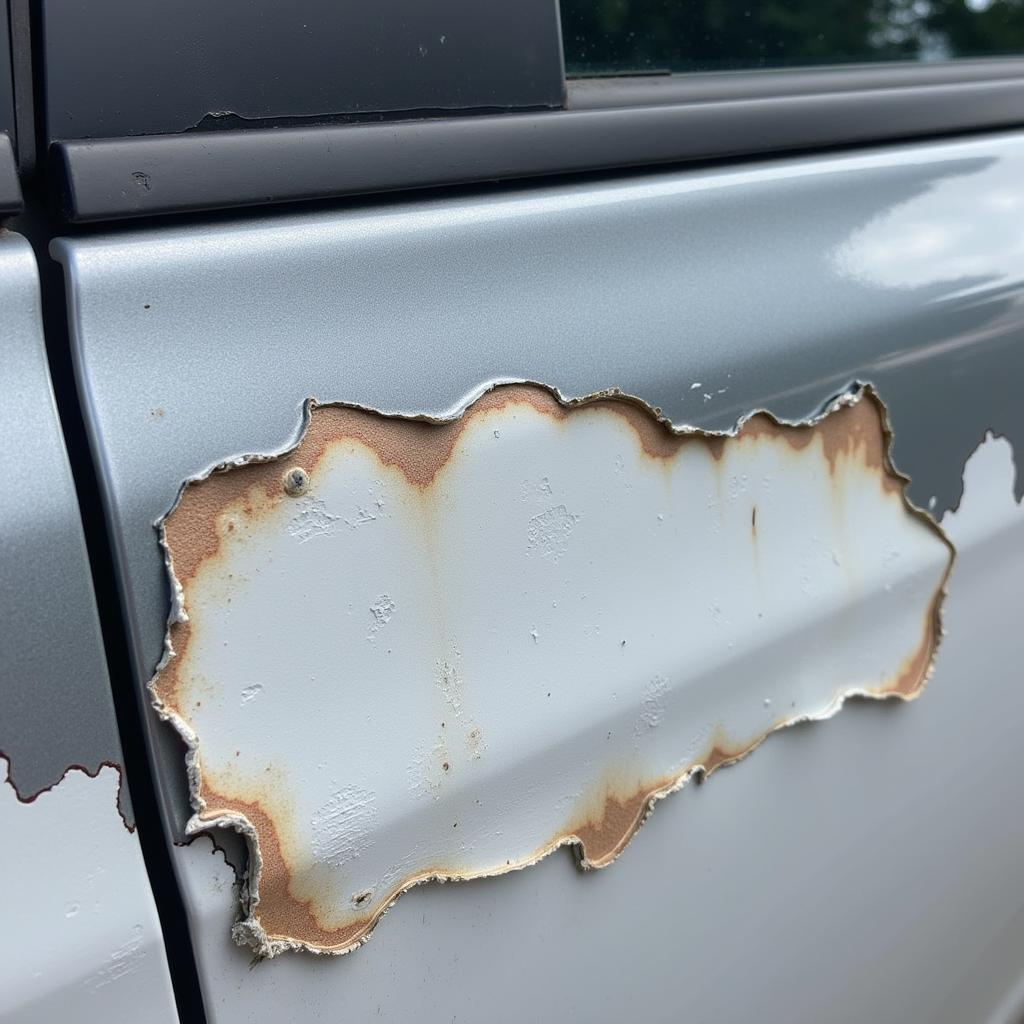Experiencing paint coming off after a car repair can be incredibly frustrating. Whether it’s peeling, flaking, or bubbling, this issue not only affects your car’s appearance but can also indicate underlying problems with the repair job itself. This article will delve into the common causes of paint failure after car repair, provide effective troubleshooting steps, and offer solutions to restore your car’s finish.
Why is My Car’s Paint Peeling After Repair?
Several factors can contribute to paint failure after a car repair. Improper surface preparation is a leading culprit. If the original surface wasn’t thoroughly cleaned and prepped before the new paint was applied, adhesion issues can arise, leading to peeling or flaking. Incompatible paint types can also cause problems. Using a different type of paint over the existing finish without proper priming can result in incompatibility and subsequent paint failure. Environmental factors, like harsh weather conditions or exposure to chemicals, can also weaken the paint and cause it to detach. Finally, rushing the curing process or using inadequate drying techniques can prevent the paint from properly bonding to the surface.
Identifying the Cause of Paint Failure
Pinpointing the exact cause of your paint issue is crucial for determining the appropriate solution. Start by carefully examining the affected area. Is the paint peeling in sheets, or is it bubbling and blistering? Is the peeling localized to the repaired area, or is it spreading to other parts of the car? These observations can offer clues about the underlying problem.
Consider the type of repair that was performed. Was it a minor scratch repair or a more extensive bodywork job? The extent of the repair can influence the likelihood of certain types of paint problems. If you had bodywork done, check for signs of improper filler application or sanding, as these can also contribute to paint issues.
Solutions for Paint Coming Off After Car Repair
Depending on the severity and cause of the paint failure, several solutions are available. For minor peeling or chipping, you might be able to touch up the area with matching paint. However, if the problem is more widespread or caused by improper surface preparation, a complete repaint of the affected area might be necessary. In some cases, stripping the existing paint and starting from scratch might be the best option to ensure long-lasting results.
“Proper surface preparation is the foundation of any successful paint job,” says renowned auto body expert, John Smith, owner of Smith Auto Body. “Cutting corners in this stage will almost certainly lead to problems down the road.”
Preventing Future Paint Problems
Preventing future paint problems involves careful planning and execution during the repair process. Ensure the repair shop uses high-quality paint products that are compatible with your car’s existing finish. Insist on thorough surface preparation, including cleaning, sanding, and priming. Confirm that the shop uses proper drying and curing techniques to allow the paint to fully adhere and harden. Finally, protect your car’s finish by regularly waxing and washing it, and avoiding exposure to harsh chemicals or extreme weather conditions.
How to Choose a Reputable Repair Shop
Choosing a reputable repair shop is essential for preventing paint problems and ensuring a high-quality repair job. Look for shops with certified technicians and a proven track record of successful repairs. Don’t hesitate to ask for references and check online reviews. A good repair shop will be transparent about their processes and willing to answer your questions.
“Finding a trustworthy repair shop can save you time, money, and frustration in the long run,” advises Maria Garcia, a seasoned automotive consultant. “Do your research and choose a shop that prioritizes quality and customer satisfaction.”
Conclusion
Dealing with paint coming off after a car repair can be a hassle, but understanding the causes and solutions can empower you to address the issue effectively. By following the troubleshooting tips and prevention strategies outlined in this article, you can restore your car’s finish and ensure a long-lasting, beautiful paint job. Remember, choosing a reputable repair shop and emphasizing proper surface preparation are crucial for preventing future paint problems. If you’re still experiencing issues, remember you can always reach out for professional help.
FAQ
-
Why is my car paint bubbling after repair?
Bubbling paint can indicate trapped moisture or solvents beneath the surface, often due to improper preparation or application. -
Can I fix peeling paint myself?
Minor peeling can sometimes be addressed with touch-up paint, but larger areas might require professional repair. -
How long should car paint last after a repair?
With proper care and maintenance, a professional paint job should last for several years. -
How can I tell if a repair shop is reputable?
Look for certifications, check online reviews, and ask for references. -
What should I do if the paint problem persists after a repair?
Contact the repair shop and explain the issue. A reputable shop will work with you to find a solution. -
How can I prevent paint issues in future car repairs?
Choose a reputable shop, insist on quality materials and thorough surface preparation, and protect your car’s finish with regular maintenance. -
What are the signs of improper car paint repair?
Signs include peeling, bubbling, flaking, orange peel texture, and color mismatch.
Need help with your car repair? Contact us via WhatsApp: +1(641)206-8880 or Email: [email protected]. Our 24/7 customer support team is ready to assist you.


